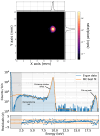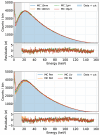Silicon Drift Detectors for the Measurement and Reconstruction of Beta Spectra
- PMID: 39771936
- PMCID: PMC11679017
- DOI: 10.3390/s24248202
Silicon Drift Detectors for the Measurement and Reconstruction of Beta Spectra
Abstract
The ASPECT-BET project, or An sdd-SPECTrometer for BETa decay studies, aims to develop a novel technique for the precise measurement of forbidden beta spectra in the 10 keV-1 MeV range. This technique employs a Silicon Drift Detector (SDD) as the main spectrometer with the option of a veto system to reject events exhibiting only partial energy deposition in the SDD. A precise understanding of the spectrometer's response to electrons is crucial for accurately reconstructing the theoretical shape of the beta spectrum. To compute this response, GEANT4 simulations optimized for low-energy electron interactions are used and validated with a custom-made electron gun. In this article we present the performance of these simulations in reconstructing the electron spectra measured with SDDs of a 109Cd monochromatic source, both in vacuum and in air. The allowed beta spectrum of a 14C source was also measured and analyzed, proving that this system is suitable for the application in ASPECT-BET.
Keywords: GEANT4 simulations; silicon drift detectors; β spectra.
Conflict of interest statement
The authors declare no conflicts of interest. The funders had no role in the design of the study; in the collection, analyses, or interpretation of data; in the writing of the manuscript; or in the decision to publish the results.
Figures















References
-
- Barea J., Kotila J., Iachello F. Nuclear matrix elements for double-β decay. Phys. Rev. C. 2013;87:014315. doi: 10.1103/PhysRevC.87.014315. - DOI
-
- Hayes A.C., Friar J.L., Garvey G.T., Jungman G., Jonkmans G. Systematic Uncertainties in the Analysis of the Reactor Neutrino Anomaly. Phys. Rev. Lett. 2014;112:202501. doi: 10.1103/PhysRevLett.112.202501. - DOI
-
- Kostensalo J., Haaranen M., Suhonen J. Electron spectra in forbidden β decays and the quenching of the weak axial-vector coupling constant gA. Phys. Rev. C. 2017;95:044313. doi: 10.1103/PhysRevC.95.044313. - DOI
-
- Quarati F.G.A., Bollen G., Dorenbos P., Eibach M., Gulyuz K., Hamaker A., Izzo C., Keblbeck D.K., Mougeot X., Puentes D., et al. Measurements and computational analysis of the natural decay of 176Lu. Phys. Rev. C. 2023;107:024313. doi: 10.1103/PhysRevC.107.024313. - DOI
-
- Bodenstein-Dresler L., Chu Y., Gehre D., Gößling C., Heimbold A., Herrmann C., Hodak R., Kostensalo J., Kröninger K., Küttler J., et al. Quenching of gA deduced from the β-spectrum shape of 113Cd measured with the COBRA experiment. Phys. Lett. B. 2020;800:135092. doi: 10.1016/j.physletb.2019.135092. - DOI
Grants and funding
LinkOut - more resources
Full Text Sources

